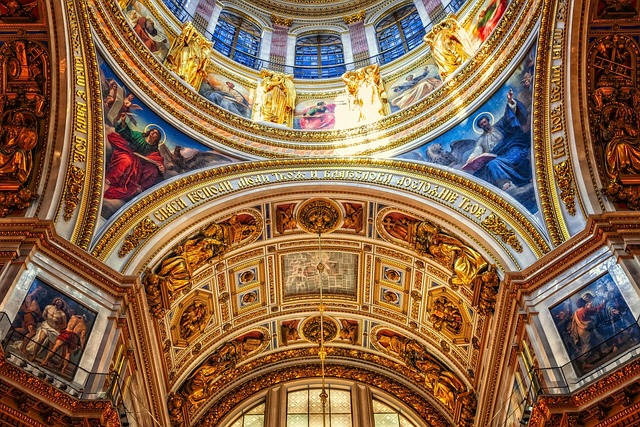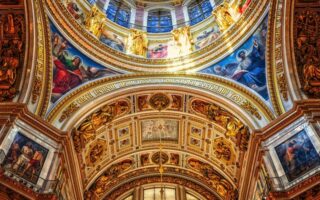Orthodox prayer is an integral part of the spiritual life of Orthodox Christians. It is a deeply rooted tradition that encompasses various forms and practices. Orthodox prayer is characterized by its emphasis on the use of set prayers, repetitive chants, and the involvement of the entire body in worship. This introduction provides a brief overview of how Orthodox Christians engage in prayer.
Table of Contents
The Significance of Icons in Orthodox Prayer
Orthodox Christianity is known for its rich and vibrant prayer traditions. One of the most distinctive aspects of Orthodox prayer is the use of icons. Icons are sacred images that depict Christ, the Virgin Mary, and various saints. They are not mere decorations, but rather powerful tools that aid in the communication between the worshipper and the divine.
Icons hold a significant place in Orthodox prayer because they serve as windows to the spiritual realm. When Orthodox Christians pray before an icon, they believe that they are not just looking at a piece of art, but rather encountering the presence of the person depicted. Icons are seen as a means of connecting with the divine and fostering a deeper spiritual experience.
The use of icons in Orthodox prayer can be traced back to the early days of Christianity. In the early Church, icons were used to teach and inspire believers. They were seen as visual representations of the Gospel and served as a way to communicate the stories and teachings of Christ and the saints. Icons were also used to remind believers of the presence of the divine in their lives and to encourage them in their faith.
Icons are not worshipped in Orthodox Christianity, but rather venerated. Veneration is a form of respect and honor given to the person depicted in the icon. When an Orthodox Christian prays before an icon, they may kiss it, light a candle, or offer incense as a sign of reverence. These acts of veneration are not directed towards the physical object, but rather towards the person represented in the icon.
Icons are also used as aids in Orthodox prayer. They serve as focal points, helping to direct the worshipper’s attention and focus their thoughts on God. When an Orthodox Christian prays before an icon, they may use it as a visual aid to help them enter into a state of prayerful contemplation. The icon becomes a gateway to the spiritual realm, a reminder of the presence of God, and a source of inspiration and guidance.
Icons are not limited to churches and monasteries; they are also found in Orthodox homes. Many Orthodox Christians have a prayer corner or icon corner in their homes, where they set up a small shrine with icons, candles, and other religious items. This prayer corner serves as a sacred space for personal prayer and reflection, a place where the individual can connect with God and seek spiritual nourishment.
The significance of icons in Orthodox prayer goes beyond their aesthetic value. They are not just beautiful works of art; they are powerful tools that aid in the worshipper’s spiritual journey. Icons serve as windows to the divine, reminding believers of the presence of God and the saints in their lives. They help to focus the mind and heart on prayer, fostering a deeper connection with the divine. Whether in a church or in a home, icons play a vital role in Orthodox prayer, enriching the worshipper’s experience and deepening their faith.
Understanding the Role of Incense in Orthodox Worship

Orthodox Christianity is known for its rich and vibrant worship traditions. From the ornate icons to the melodic chants, every aspect of the Orthodox liturgy is carefully crafted to create a sense of awe and reverence. One of the most distinctive elements of Orthodox worship is the use of incense. In this article, we will explore the role of incense in Orthodox worship and how it enhances the prayer experience.
Incense has been used in religious rituals for thousands of years, and its use in Orthodox worship dates back to the early days of the Church. In the Old Testament, incense was used in the Temple as a symbol of prayer and worship. The smoke rising from the burning incense was seen as a way to carry the prayers of the faithful to heaven. This tradition was carried over into the Christian Church, where incense became an integral part of the liturgy.
In Orthodox worship, incense is used in a variety of ways. It is often burned in a censer, a metal container with chains that allow it to be swung back and forth. The priest or deacon will walk around the church, swinging the censer and filling the air with the sweet aroma of incense. This ritual is known as the censing of the church, and it is done at various points during the liturgy.
The use of incense serves several purposes in Orthodox worship. First and foremost, it is a way to honor and glorify God. The sweet smell of incense is seen as a pleasing offering to God, and it is a way for the faithful to show their love and devotion. As the smoke rises, it symbolizes the prayers of the people ascending to heaven, just as in the Old Testament.
In addition to its symbolic significance, incense also has practical benefits in the worship service. The smoke helps to purify the air and create a sense of sacred space. It can also help to focus the mind and create a sense of calm and tranquility. Many people find the scent of incense to be soothing and comforting, and it can help to create a peaceful atmosphere for prayer and worship.
The use of incense is not limited to the liturgy itself. In Orthodox tradition, incense is also used in private prayer. Many Orthodox Christians have a small censer in their homes, and they will burn incense as they pray. This practice helps to create a sense of continuity between the worship service and daily life, and it serves as a reminder of the presence of God in all aspects of life.
While the use of incense is an important part of Orthodox worship, it is not meant to be a distraction or an end in itself. Rather, it is a tool that helps to enhance the prayer experience and create a sense of reverence and awe. The sweet smell of incense, the rising smoke, and the rhythmic swinging of the censer all work together to create a multisensory experience that engages both the body and the spirit.
In conclusion, the use of incense in Orthodox worship is a deeply meaningful and ancient tradition. It serves as a way to honor and glorify God, to create a sense of sacred space, and to enhance the prayer experience. Whether in the grandeur of the church or the intimacy of the home, the sweet aroma of incense reminds Orthodox Christians of the presence of God and invites them into a deeper connection with the divine.
The Importance of Chanting and Singing in Orthodox Prayers
Orthodox Christianity is known for its rich and vibrant liturgical tradition, which includes a variety of prayers and hymns. One of the most distinctive aspects of Orthodox prayer is the use of chanting and singing. This article will explore the importance of chanting and singing in Orthodox prayers and how it enhances the spiritual experience.
Chanting and singing play a crucial role in Orthodox worship because they help to create a sacred atmosphere. When Orthodox Christians gather for prayer, they enter into a space that is set apart from the ordinary world. The use of music, particularly chanting, helps to transport the worshipper into a realm of transcendence and beauty. The melodic and rhythmic patterns of the chants have a way of captivating the senses and drawing the worshipper into a deeper state of prayer.
In addition to creating a sacred atmosphere, chanting and singing also serve as a form of prayer in themselves. The words of the prayers and hymns are not merely recited, but are sung with intention and devotion. This act of singing becomes a way for the worshipper to offer their prayers to God in a more heartfelt and expressive manner. The melodies and harmonies of the chants allow the worshipper to engage their whole being in prayer, uniting their mind, body, and spirit in worship.
Furthermore, chanting and singing in Orthodox prayers help to foster a sense of community and unity among the worshippers. When the congregation joins together in singing, they become a single voice, expressing their faith and devotion as one body. This communal aspect of chanting and singing is particularly evident during the Divine Liturgy, the central worship service of the Orthodox Church. The hymns and chants sung during the Liturgy are meant to be sung by the entire congregation, creating a sense of unity and shared worship.
The use of chanting and singing in Orthodox prayers also serves as a means of teaching and transmitting the faith. Many of the hymns and chants used in Orthodox worship are ancient, passed down through generations of believers. By singing these hymns, Orthodox Christians connect themselves to the rich history and tradition of their faith. The melodies and lyrics of the chants often contain deep theological truths and teachings, which are passed on to future generations through the act of singing. In this way, chanting and singing become a powerful tool for preserving and transmitting the Orthodox faith.
In conclusion, chanting and singing are integral to Orthodox prayers because they create a sacred atmosphere, serve as a form of prayer in themselves, foster a sense of community and unity, and transmit the faith to future generations. The use of music in Orthodox worship enhances the spiritual experience and allows the worshipper to engage their whole being in prayer. Whether it is the melodic chants of the Divine Liturgy or the heartfelt hymns of personal devotion, chanting and singing play a vital role in Orthodox prayer, enriching the worshipper’s connection with God and their fellow believers.
Exploring the Symbolism of Orthodox Prayer Postures
Orthodox prayer is a beautiful and deeply symbolic practice that encompasses various postures. These postures are not just physical movements, but rather, they hold profound meaning and significance. In this article, we will explore the symbolism behind the different prayer postures in Orthodox tradition.
One of the most common prayer postures in Orthodoxy is standing. When Orthodox Christians stand to pray, it represents their readiness and attentiveness before God. It is a posture of respect and reverence, acknowledging the presence of the divine. Standing also signifies the spiritual strength and endurance required in the journey of faith.
Another important prayer posture in Orthodoxy is kneeling. Kneeling is an act of humility and surrender before God. By bending the knees and lowering oneself, Orthodox believers express their recognition of their own unworthiness and their complete dependence on God’s mercy and grace. Kneeling is a powerful reminder that we are not in control, but rather, we submit ourselves to the will of God.
In addition to standing and kneeling, Orthodox Christians also engage in prostration during prayer. Prostration involves fully bowing down with the forehead touching the ground. This posture signifies complete submission and surrender to God. It is an act of self-emptying and a recognition of God’s infinite greatness. Prostration is a physical expression of the desire to be in complete union with God, leaving behind all worldly distractions and attachments.
The sign of the cross is another important aspect of Orthodox prayer postures. Making the sign of the cross involves touching the forehead, chest, and both shoulders, while saying, “In the name of the Father, and of the Son, and of the Holy Spirit.” This gesture represents the belief in the Holy Trinity and serves as a reminder of the central role of Christ in the life of a believer. The sign of the cross is a way to invoke God’s presence and protection, as well as a means of expressing faith and devotion.
It is important to note that these prayer postures are not mere rituals or empty gestures. They are deeply rooted in the Orthodox understanding of the human person and their relationship with God. Each posture carries a spiritual significance and serves as a means of connecting with the divine.
Orthodox prayer postures are not limited to formal church services or private devotions. They can be incorporated into daily life, reminding believers of their constant need for God’s presence and guidance. Whether standing, kneeling, or prostrating, Orthodox Christians seek to cultivate a spirit of prayerfulness in all aspects of their lives.
In conclusion, the symbolism of Orthodox prayer postures is rich and profound. Standing represents readiness and attentiveness, kneeling signifies humility and surrender, prostration expresses complete submission, and the sign of the cross invokes the presence and protection of God. These postures are not just physical movements, but rather, they are powerful ways to connect with the divine and deepen one’s relationship with God. So, the next time you see an Orthodox Christian engaged in prayer, take a moment to appreciate the deep symbolism behind their posture and the spiritual journey it represents.
Conclusion
In conclusion, Orthodox prayer is a central aspect of the Orthodox Christian faith. It involves various elements such as standing, making the sign of the cross, and reciting prayers from liturgical texts. Orthodox believers engage in both personal and communal prayer, seeking to connect with God and seek His guidance and blessings. The use of icons, incense, and liturgical chants further enhance the prayer experience. Overall, Orthodox prayer is a deeply reverent and integral part of the Orthodox Christian tradition.
For licensing reasons, we must provide the following notice: This content was created in part with the help of an AI.


